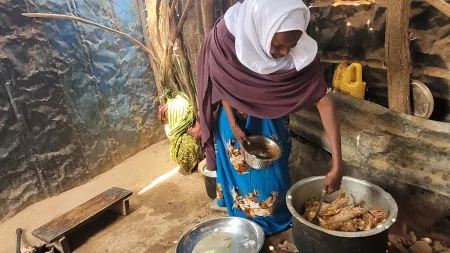If you need health care, who makes the decisions about where you go, when you can visit a health center, and what treatment you can get? Do you have to ask permission from someone in your house? In Somalia, at the start of the project, 79% of women couldn’t make decisions themselves about when they or their kids got health care. 85% said they needed a husband’s permission to visit a clinic. By the end of the project, only 17% of women said they couldn’t make decisions about health care.
The Economic Support for COVID-19 affected Women ran from March to September 2021 with $100,000 in support form the Tiffany Foundation. It reached 1,200 women directly, and 6,000 people indirectly.
What changed?
- People eat more food. The number of people who were eating enough food went from 3% to 73% during the project—24 times better than before the project. Families were 87% less likely to report they had to eat less food.
- Diets are more diverse. Families are twice as likely to have diverse diets. Women are 56% more likely to be eating the micronutrients they need to stay healthy.
- More kids got their shots. The number of kids who are getting their shots on schedule went up 2.7 times. Kids are 46% more likely to have gotten polio vaccines and 36% more likely to get their tuberculosis vaccines.
- Women can make choices. Women are four times more likely to be able to decide to get health care for themselves or their children by themselves—up to 83% at the end of the project. They were also 50% more likely to be able to make decisions about what the family ate (72% at the end of the project).
- Families are more likely to be spacing out births. People are 3.7 times more likely to think you should wait two years between pregnancies (up to 85%). They are also 3.3 times more likely to know how to delay pregnancy.
- People are less likely to support child marriage and early pregnancy. The number of people who think that girls should have their first child at age 15 dropped from 15% to 0%.
How did we do it?
- Get people cash. The project gave cash transfers of $80 per month to each family in the project.
- Integrate your services. In addition to cash, the project gave people access to information, referrals to health services, and counselling on key topics around health and equality.
- Listen to feedback. 98% of people in the project knew how to give feedback if they had a problem.
- Pay attention to violence. The project provided referrals, care, and other support to survivors of Gender Based Violence.
- Look at the quality of health care. The project connected women to pre-natal health services, family planning supplies, and childhood nutrition and vaccination campaigns.
Want to learn more?
Check out the final evaluation here.
